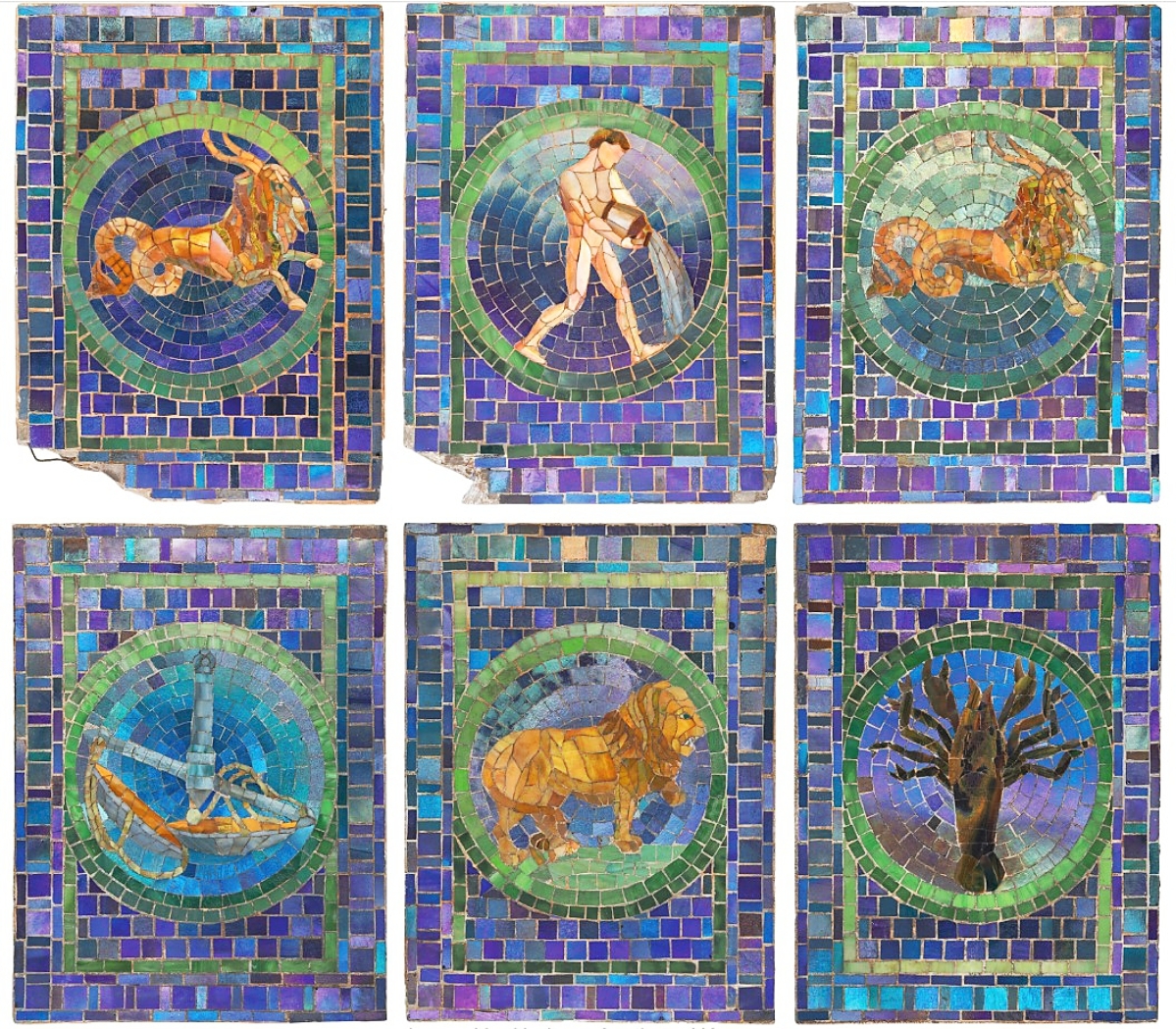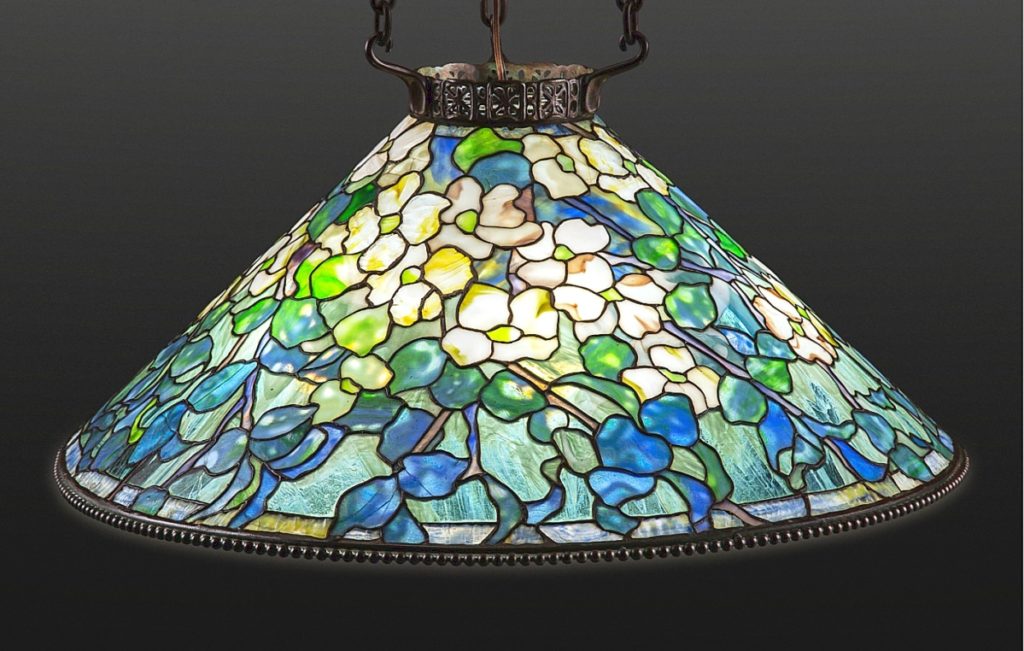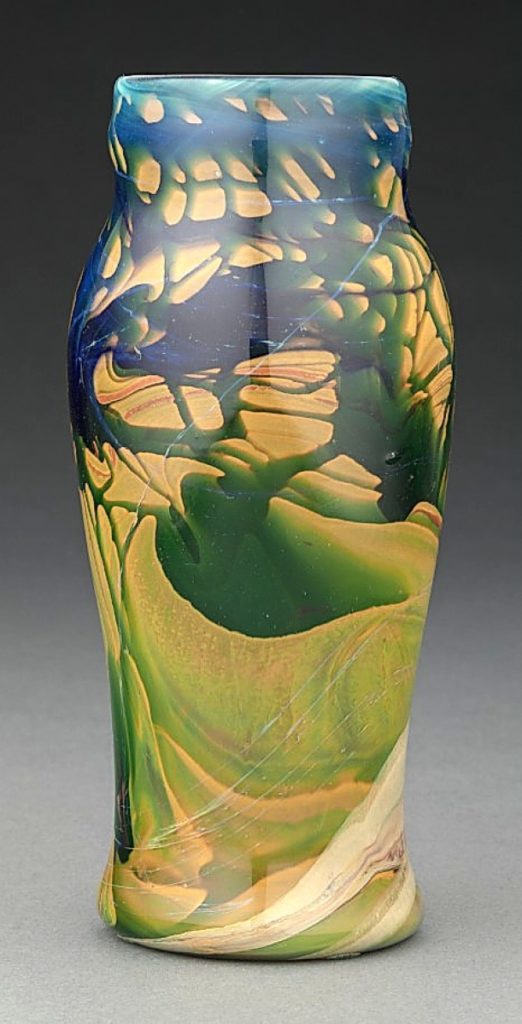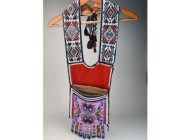
Six Tiffany Studios Favrile glass mosaic panels made for the Marshall Field & Company, 1914, touched the stars for $57,500.
Review by Z.G. Burnett, Photos Courtesy Heritage Auctions
DALLAS – Heritage Auctions conducted its Pursuit of Beauty: Art Nouveau, Art Deco & Art Glass Signature® Auction on September 28, totaling $1,192,040. Tiffany Studios and R. Lalique pieces competed for the most top lots, but other makers also made the upper ranks of this 456-lot sale. In addition to lamps and vases, historic glass from landmark buildings of the era were offered by Heritage Auctions in this stately sale.
The star of the auction was a group lot of six rare mosaic panels depicting signs from the Western Zodiac, made by Tiffany Studios for the Marshall Field & Company in Chicago, including Favrile glass tiles that were also salvaged at the time of their removal. Tiffany began producing its mosaic panels for ecclesiastical and public spaces, later applying the medium to commercial and domestic spaces. These panels, including Aquarius, Libra, Leo, Cancer and two Capricorns, were part of what was then considered “the largest piece of mosaic glass in the world” installed in the new Marshall Field & Co building. Designed by D.H. Burnham & Company and opened in 1907, the ten-story Classical Revival monument to luxury occupies an entire city block and is still one of the largest department stores in existence. In 1914, Marshall Field commissioned Louis Comfort Tiffany to design the ceiling above the Men’s Grill in its new Store for Men. The tiles composed a massive 40-by-50-foot leaded glass dome above an extravagant central fountain, joining more than one million glass tesserae that took 50 men and 18 months to install. These panels “were a joy to handle,” according to Samantha Robinson, consignment director of decorative arts and design, and led the sale at $57,500.
No Art Nouveau glass sale would be complete without a salon full of Tiffany lamps, but the only floor lamp in the top lots was also the auction’s second highest lot. At 78 overall inches, the leaded bronze and patinated glass lamp from Tiffany Studios was made circa 1910 and signed on its shade and base. The Curtain Border shade contained yellow and blue-dappled mosaic glass, with spiral detailing on its base. The lamp achieved $52,500. The third highest lot was also the only example of its form, a hanging Tiffany Studios lamp from the same era with a Dogwood pattern, which sold for $45,000. Another circa 1910 Tiffany table lamp with marks to its Linenfold shade and base folded at $16,250.

This Dogwood-pattern hanging lamp from Tiffany Studios bloomed for $45,000.
Two more Tiffany lamps were sold, both with lobed Lily pendants made with Favrile glass, circa 1910. Each of these lamps have similar examples in Alistair Duncan’s Tiffany Lamps and Metalware: An illustrated reference to over 2000 models (2007). The Lily shades were all marked “L.C.T. Favrile” and their bases showed the appropriate Tiffany marks. The first in the sale was a 10-light table lamp with a patinaed bronze in the shape of lily pads, reaching $28,750. The second had the same base, but only seven Lily lights, which earned $21,250.
The only lot of decorative Tiffany glass was a decorated paperweight vase made from Favrile glass, circa 1950. An early example of the studio’s Agate designs, the decoration showed abstracted leaves and vines in teal, lapis and green, along with swaths of cream and ochre and encased in clear glass. The vase paperweight was in overall good condition with a few short, barely perceptible surface scratches on the shoulder, and bid to $31,250.
Glass from René Lalique also joined the upper lists of this sale, with the maker’s vases being most popular among bidders. The highest achieving of these was a Perruches cased vase in a rare red color, circa 1919. The vase was in overall very good condition with no chips, cracks or restoration, and sold for $30,000. Another vase in the same Perruches form, but in electric blue glass with one fleabite to the tail of one parakeet, followed at $25,000. Between the Perruches vases lurked another Lalique, but this vase was in the form of a coiled serpent with its jaws open. Made with amber glass circa 1924, the vase was in overall good condition. It struck at $27,500.
Twelve bronze sculptures were included in the sale, and the highest selling was the only example that lacked the sinuous lines and idealized forms of most Art Nouveau and Art Deco sculpture. “Tête d’homme” was cast in 1914 by the Guss Barth Rinteln foundry after Joseph Csaky, who was born in Hungary, then part of the Austro-Hungarian Empire, then traveled by foot to Paris to pursue an artistic career after an early career in ceramic and metalwork factories. He joined the artist’s collective La Ruche in Montparnasse and began to carve sculptures in stone. Csaky was a contemporary with Alexander Archipenko and Pablo Picasso in the Cubist movement, and his work is considered to be a substantial contribution to modern nonrepresentational sculpture. The bronze sold by Heritage was modeled after Csaky’s 1913 “Tête d’homme,” a plaster sculpture that was exhibited widely in Paris and Geneva and is now lost. The bust was originally bought from the artist’s estate and went through three private German collections before being bought by its consignor from a New Orleans gallery; it bid to $16,250.

This early Favrile glass paperweight vase from Tiffany Studios, circa 1905, achieved $31,250.
Two Daum pieces reached the top lots during this sale. An acid-etched and enameled boudoir lamp sold for $15,625, showing a springtime landscape scene that becomes illuminated from an interior bulb when lit. The lamp was marked with “Daum Nancy” and Cross of Lorraine, and was also signed by its decorator, “B.S.” The lamp was joined by a rare partial-gilt and enameled vase with three handles, circa 1895, decorated with storks in a pond with copper leaves. The vase also bore the appropriate marks and came from a private Chicago collection of American and European art glass and bid to $14,375.
Another collection of tilework was included in the auction; a rare, glazed earthenware fireplace surround from the Grueby Faience Company, circa 1902. From the auction catalog, “The fireplace was the heart of the Arts & Crafts home – a place to gather as a family and foster unity. As the anchor of the room, both visually and socially, the fireplace was an opportunity to show off the best design of the time. The star of this surround by the Grueby Faience Company is the charming five-tile Oxen frieze, featuring a farmer accompanying an oxen-drawn wagon, executed in the rich greens, earthy yellows and warm browns Grueby is known for. The rustic scene captures the essence of the Arts and Crafts Movement: simple design made by expert craftsmen that ties together the beauty of nature with the comfort and harmony of a peaceful home. The frieze was originally designed in 1902 for the library fireplace in copper magnate Thomas W. Lawson’s Massachusetts farmhouse, Dreamworld. The design, pictured in contemporary periodicals, became such a hit with clients that Grueby put it into wider production. The original owners of this particular Oxen example paired it with plain tiles glazed in Grueby’s signature curdled matte green, 36 of which are still extant and offered here.” The surround was deaccessioned from the Birks Museum collection of Millikin University in Decatur, Ill., and sold for $15,000.
Prices quoted with buyer’s premium as reported by the auction house. Heritage’s next Pursuit of Beauty sale will be January 25; the consignment deadline is November 15. For information, 214-528-3500 or www.ha.com.


















